"Better-Than-Takeout" Cauliflower Fried Rice
11 minute read
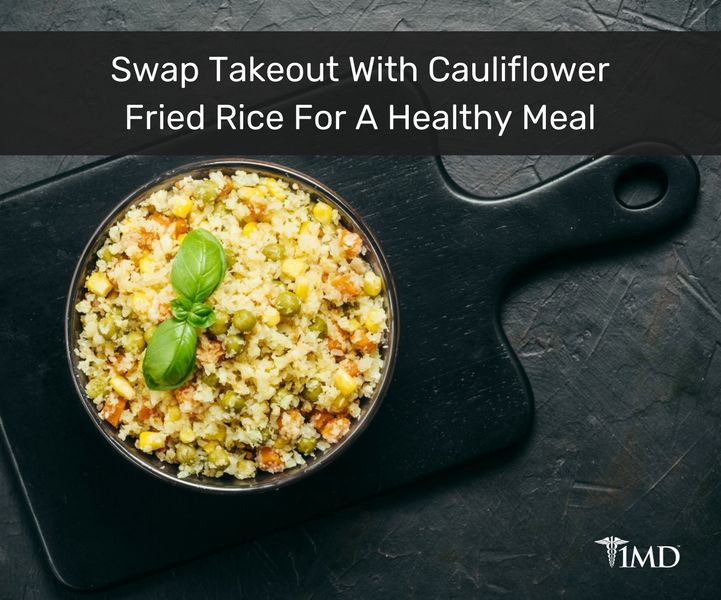
After a long day, it’s tempting to order takeout or to stop by a sit down restaurant but did you know that frequent meals out can lead to weight gain and may impact your health? The National Health Examination Survey examined frequency of fast food meals, along with metabolic biomarkers such as BMI, serum cholesterol and triglycerides, blood glucose, and micronutrient levels. Those who reported frequent restaurant and fast food meals had higher BMIs and lower HDL (good) cholesterol.
Eating Out & Rising Obesity Rates
Fast food has long been associated with obesity, arteriosclerosis, and poor health but it turns out even sit-down and fast casual restaurant meals may contain high levels of sodium, saturated fat, and calories.
According to OECD reports, the United States has the highest concentration of obesity across the globe, with close to 40 percent of adults over age 15 classified as obese; the worldwide statistic is one in two adults and one in six children. Americans spend more of their food dollars outside the home than preparing meals at home.
| Related: Antibiotics in Fast Food: See How 25 Top Chains Rank |
Studies indicate that the rise in obesity parallels the increased percentage of foods consumed outside the home and the increase in portion size. Larger portion sizes increase consumption of energy or calories and may confuse those attempting to follow diet advice according to USDA and FDA standards.
While restaurants are offering healthy alternatives, meals consumed away from home may contain 2,000 calories or more when average recommended intake for adults ranges between 1600 to 2400 calories. As the percentage of restaurant meals has increased, so has the obesity rate.
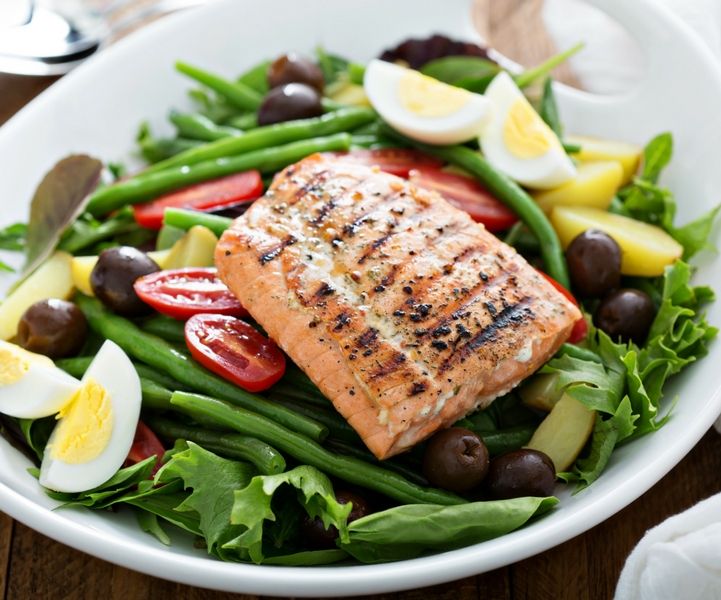
Tips to Healthier Dining
1. Avoid banking all your calories before a restaurant meal. Instead of skipping meals, eat lightly if you plan to indulge later in the evening. If you arrive at a restaurant starving, you’ll be enticed to order fried appetizers, sugary cocktails, heavier entrees, or dessert.
2. Watch the menu. Look for words like baked, broiled, grilled, and steam. Stay clear of terms like fried, crusted, stuffed, rich, cheesy, or buttery, which will not only contain more calories but likely also trans fats or saturated fats.
| Related: Top 10 Restaurants To Dine At That Won't Blow Your Diet |
3. Balance your plate. Whether you’re preparing your own meal or ordering takeout, include non-starchy vegetables, a lean protein, and complex carbohydrates with a healthy fat such as olive oil or avocado.
4. Order your way. Order whole wheat pasta and dressing or sauce on the side. Fork dip salad dressing or ask for oil and vinegar or lemon. Make healthy swaps.
5. Be selective. If you want a glass or wine or cocktail, skip the bread basket. In the mood for fries? Order your burger wrapped in lettuce and without mayo or special sauce.
6. Limit portion size. How much you end up eating can actually be more important than what you eat. Over 90 percent of restaurant meals contain more calories than advised for a meal and some even contain more than the recommended intake for a day.
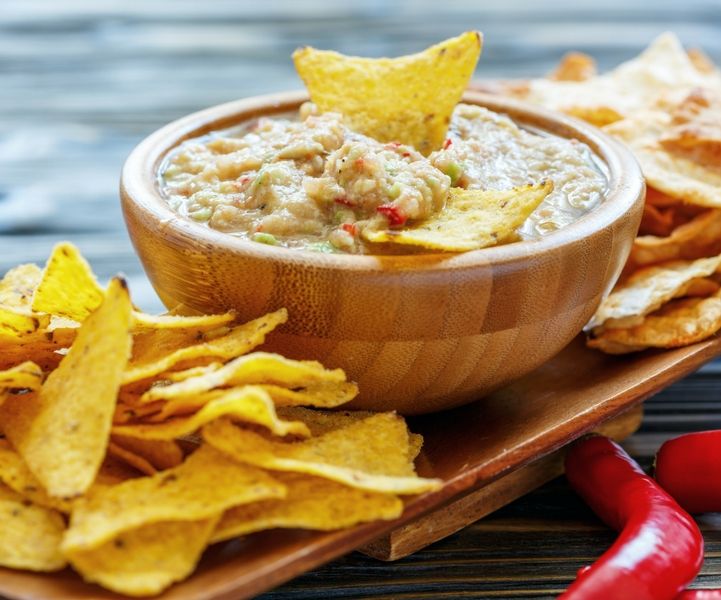
How to Control Portion Sizes
Since the 1970s, portion sizes of most foods have at least doubled, leading to overconsumption of calories, fat, sugar, and sodium, as well as weight gain. The Academy of Nutrition and Dietetics has sound advice for those aiming to control portion size when eating out.
Do the legwork. Check out the choices before you arrive at the restaurant to avoid impulse ordering. You will be better equipped to make healthier selections and if there’s a dish on the menu that is more indulgent, you can make lighter choices for the rest of the day.
Make healthy choices. Since close to half of food spending happens away from home, eating out is not only for special occasions. Aim for more balanced meals featuring lean proteins, plenty of vegetables, and whole grains.
Watch the extras. It’s easy to consume hundreds of calories in soft drinks or cocktails or chip and guacamole while you’re waiting for your meal.
Sub your sides. Order a side salad instead of fries or if you do want fries, skip the bun and order a small instead of supersizing.
Size counts. Share an entree or wrap up leftovers for another meal. Choose an appetizer along with a salad or soup instead of a main dish.
Take your time. Your brain registers that you’re satisfied about twenty minutes after you’ve finished eating. Avoid checking your phone while you’re eating because you’ll be distracted and you will not be aware of what you’re eaten.
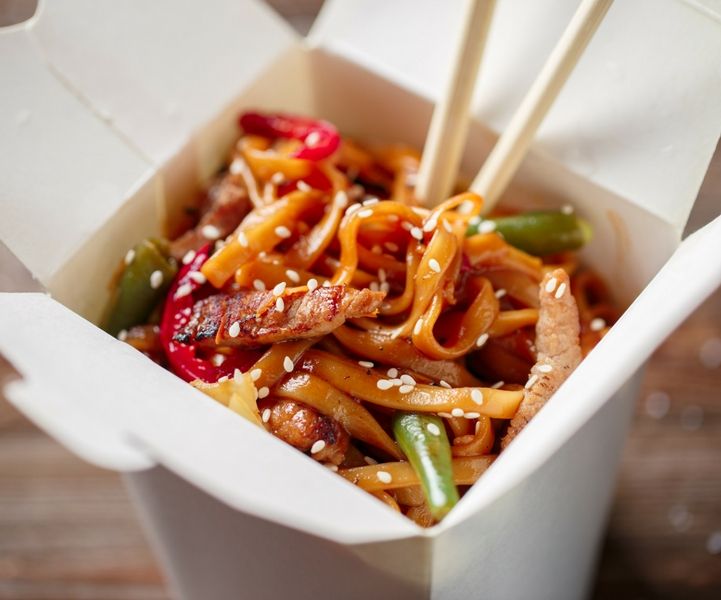
Isn’t Chinese Food Healthy?
Chinese cuisine has a reputation as healthy and depending on the dishes ordered, that can be true, depending on dishes ordered and portion size. Diet experts and nutritionists recommend steamed dumplings and entrees, small portions of brown rice, and plenty of vegetables.
Avoid anything breaded or fried, as well as heavy, typically sugar- and sodium-laden sauces. Start with soup. A cup of wonton soup has about 100 calories and keeps your appetite at bay.
If you are craving orange chicken or lo mein, share the dish along with steamed vegetables or pack at least half of the dish as leftovers. Orange beef, which is breaded, fried, and in a sweet sauce, can contain as much as 1200 calories per dish. Fried rice typically can have as much as double the calories as steamed rice, along with higher levels of sodium and fat.
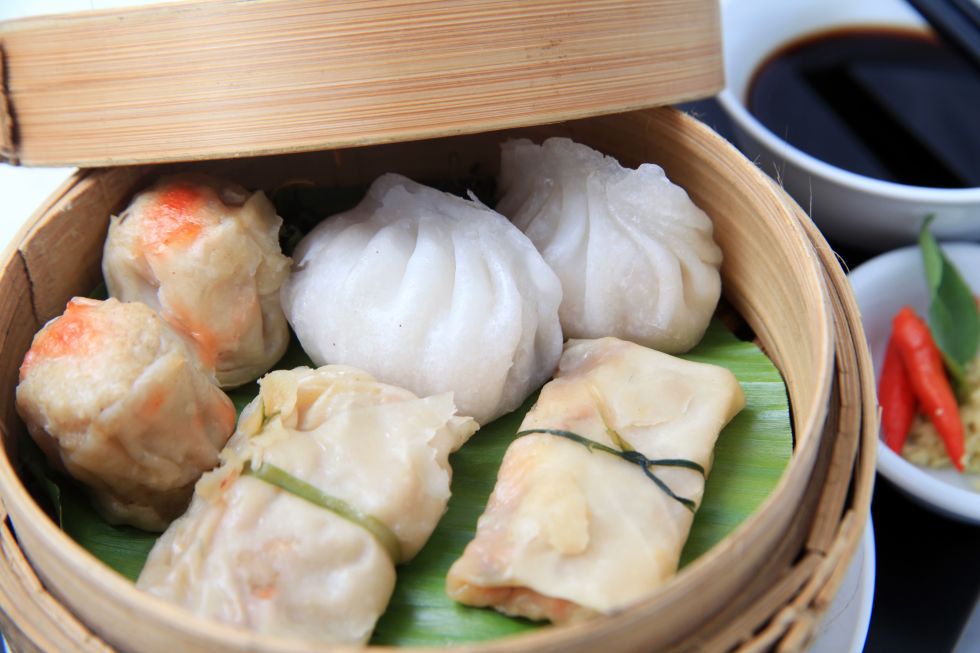
One from Column A
When you do order Chinese takeout, choose healthier options. Soy sauce, sweet sauces, and fried foods (including those noodles with Duck sauce) are packed with fats, sodium, sugar, and calories. Here’s a list to help you choose wisely.
Avoid:
♦ Fried rice
♦ Egg rolls
♦ General Tsao’s or Sweet and Sour Chicken, Shrimp, or Beef
♦ Lo Mein
♦ Fried Tofu
Order:
♦ Wonton or Hot and Sour Soup
♦ Steamed Vegetable Dumplings
♦ Shrimp and Broccoli
♦ Steamed Buddha’s Feast
Better yet, prepare this Cauliflower Fried Rice at home for takeout flavor without the extra calories, sodium, or fat. Swapping cauliflower for white rice not only saves calories but adds important nutrients to your diet.
Just one cup of cauliflower contains 77 percent of the recommended daily intake for vitamin C and 3 grams of fiber, as well as antioxidants that can reduce inflammation and protect against several chronic diseases, including cardiovascular disease, cancer, and metabolic syndrome.
The cruciferous vegetable is also high in sulforaphane, a well-studied antioxidant that may be helpful in suppressing the development of cancer cells by inhibiting enzymes that promote cancer and tumor growth.

Cauliflower Fried Rice
Serves: 4
Ingredients
Fried Rice
1 head cauliflower, cut into florets
2 tablespoons neutral oil (such as vegetable, coconut or peanut)
1 bunch scallions, thinly sliced
3 garlic cloves, minced
1 tablespoon minced fresh ginger
2 carrots, peeled and diced
2 celery stalks, diced
1 red bell pepper, diced
1 cup frozen peas
2 tablespoons rice vinegar
3 tablespoons soy sauce
2 teaspoons Sriracha, or more to taste
Garnishes
1 tablespoon neutral oil (such as vegetable, coconut or peanut)
4 eggs
Salt and freshly ground black pepper
4 tablespoons chopped fresh cilantro
4 tablespoons thinly sliced scallions
4 teaspoons sesame seeds
Instructions
1. MAKE THE RICE: In the bowl of a food processor, pulse the cauliflower until the mixture resembles rice, 2 to 3 minutes. Set aside.
2. In a large skillet, heat the oil over medium heat. Add the scallions, garlic and ginger, and stir-fry until fragrant, about 1 minute.
3. Add the carrots, celery and red bell pepper, and stir-fry until the vegetables are tender, 9 to 11 minutes.
4. Add the cauliflower rice and stir-fry until it begins to turn golden, 3 to 5 minutes more. Stir in the frozen peas and toss well to combine.
5. Add the rice vinegar, soy sauce and Sriracha, and toss to combine. Set aside.
6. MAKE THE GARNISH: In a medium skillet, heat the oil over medium-high heat. Crack the eggs directly into the pan and cook until the whites are set but the yolks are still runny, 3 to 4 minutes. Season each with salt and pepper.
7. To serve, divide the cauliflower rice among four plates and top each with a fried egg. Garnish each plate with 1 tablespoon cilantro, 1 tablespoon scallions and 1 teaspoon sesame seeds. Serve immediately.
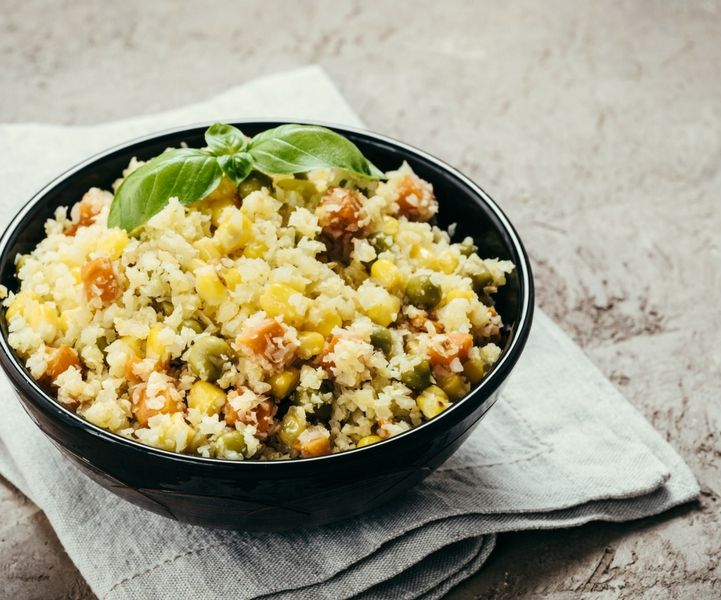
The Bottom Line
Eating out doesn’t lead to weight gain if you watch portion sizes and choose healthier options. However, preparing meals at home using whole foods is a good option to avoid consuming excess calories, sodium, sugar, and unhealthy fats.
Aim to cover half your plate in vegetables, one-quarter, whole grains and one-quarter, lean protein, along with some healthy fats like avocado or olive oil. Swapping low-nutrient ingredients like white rice or refined flour with whole grains and cauliflower can also be effective to promote health and minimize risk for weight gain and obesity.
Read Next >>> Foods Rich In Healthy Gut-Supporting Digestive Enzymes
-
https://www.purewow.com/recipes/cauliflower-fried-rice
-
https://www.huffingtonpost.com/entry/fancy-restaurant-meals-may-be-just-as-unhealthy-as-big-macs-and-fries_us_55ad10e3e4b065dfe89ec82c
-
http://www.zerohedge.com/news/2017-07-26/first-time-americans-spend-more-eating-out-food-home
-
https://www.ncbi.nlm.nih.gov/pmc/articles/PMC4400187/
-
https://www.prevention.com/weight-loss/how-to-eat-healthy-at-a-restaurant
-
https://www.prevention.com/eatclean/worst-chinese-takeout-dishes
-
http://www.eatright.org/resource/health/weight-loss/eating-out/eating-out
-
https://www.nytimes.com/interactive/2014/12/22/upshot/what-2000-calories-looks-like.html?_r=0&auth=login-email
-
https://www.cdc.gov/healthyweight/healthy_eating/portion_size.html
-
https://www.ncbi.nlm.nih.gov/pmc/articles/PMC1447051/






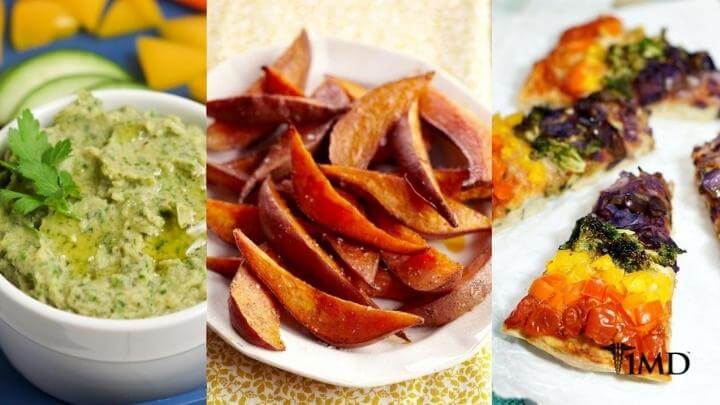
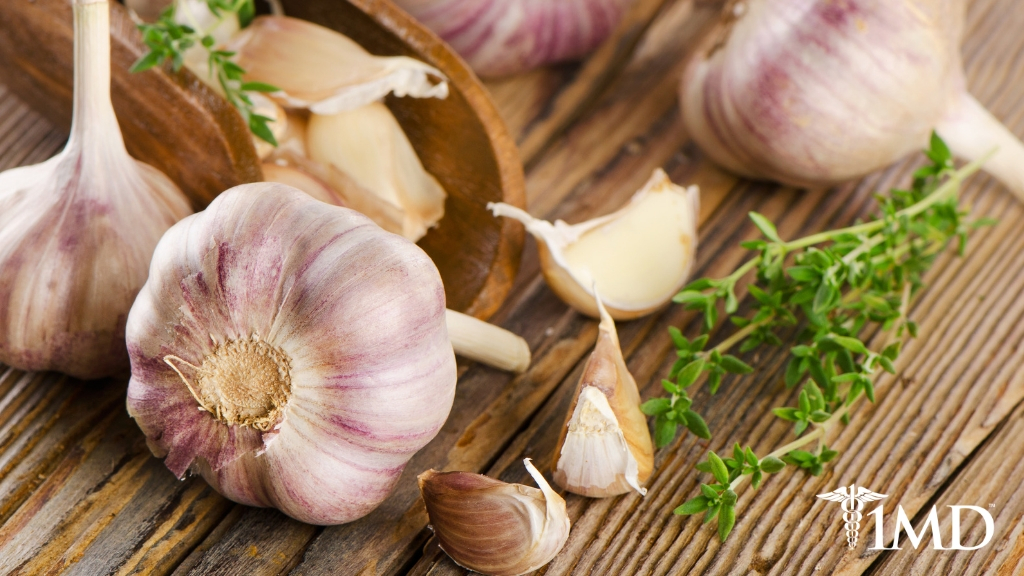
 Health Guides
Health Guides
 Latest Research
Latest Research


